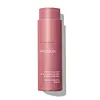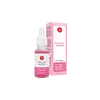What's inside
What's inside
 Key Ingredients
Key Ingredients

 Benefits
Benefits

 Concerns
Concerns

 Ingredients Side-by-side
Ingredients Side-by-side

Water
Skin ConditioningGlycolic Acid
BufferingMaltobionic Acid
BufferingBiosaccharide Gum-1
HumectantPotassium Hydroxide
BufferingPropanediol
SolventSuccinic Acid
BufferingSodium Benzoate
MaskingXanthan Gum
EmulsifyingAllantoin
Skin ConditioningDisodium EDTA
Sodium Hyaluronate
HumectantPhenoxyethanol
PreservativeTrideceth-9
EmulsifyingParfum
MaskingAdenosine
Skin ConditioningPEG-40 Hydrogenated Castor Oil
EmulsifyingSilanetriol
Cyanocobalamin
Skin ConditioningPolysorbate 20
EmulsifyingWater, Glycolic Acid, Maltobionic Acid, Biosaccharide Gum-1, Potassium Hydroxide, Propanediol, Succinic Acid, Sodium Benzoate, Xanthan Gum, Allantoin, Disodium EDTA, Sodium Hyaluronate, Phenoxyethanol, Trideceth-9, Parfum, Adenosine, PEG-40 Hydrogenated Castor Oil, Silanetriol, Cyanocobalamin, Polysorbate 20
Water
Skin ConditioningGluconolactone
Skin ConditioningButylene Glycol
HumectantGlycolic Acid
BufferingPentylene Glycol
Skin ConditioningPEG-40 Hydrogenated Castor Oil
EmulsifyingBetaine
HumectantSodium Citrate
BufferingPolyacrylate Crosspolymer-6
Emulsion StabilisingSalicylic Acid
MaskingSodium Hydroxide
BufferingPhenoxyethanol
PreservativeAllantoin
Skin ConditioningHydrolyzed Jojoba Esters
Skin ConditioningXanthan Gum
EmulsifyingAloe Barbadensis Leaf Juice
Skin ConditioningTriethylene Glycol
MaskingCI 14720
Cosmetic ColorantCI 42090
Cosmetic ColorantCI 19140
Cosmetic ColorantWater, Gluconolactone, Butylene Glycol, Glycolic Acid, Pentylene Glycol, PEG-40 Hydrogenated Castor Oil, Betaine, Sodium Citrate, Polyacrylate Crosspolymer-6, Salicylic Acid, Sodium Hydroxide, Phenoxyethanol, Allantoin, Hydrolyzed Jojoba Esters, Xanthan Gum, Aloe Barbadensis Leaf Juice, Triethylene Glycol, CI 14720, CI 42090, CI 19140
Ingredients Explained
These ingredients are found in both products.
Ingredients higher up in an ingredient list are typically present in a larger amount.
Allantoin is a soothing ingredient known for its protective and moisturizingg properties. Because of this, it is often added to products with strong active ingredients.
Studies show higher concentrations of this ingredient can promote wound healing.
Though it can be derived from the comfrey plant, allantoin is produced synthetically for cosmetic products to ensure purity.
Learn more about AllantoinGlycolic Acid is arguably the most famous alpha hydroxy acid (AHA) with tons of research backing its benefits.
It is found naturally in sugar cane but the form used in skincare is usually synthetic for purity and stability.
Glycolic acid removes the top layer of dead skin cells to allow newer and fresher ones to emerge.
AHAs work by breaking down the structural “glue” that holds old skin cells in place. When that buildup is gone, your skin can renew itself more efficiently.
Research also shows glycolic acid stimulates collagen production, helping to firm and thicken the skin over time. This is one of its biggest advantages over other AHAs.
Overall, glycolic acid helps with:
Fun fact: Glycolic acid boosts skin hydration by helping it produce molecules that increase hyaluronic acid naturally.
To work best, glycolic acid products should have a pH between 3-4 (that’s where exfoliation is most effective but still gentle on skin).
The pH and concentration of a product are key to its effectiveness:
It is normal to feel a slight stinging sensation when using glycolic acid. This usually fades as your skin adjusts.
Because glycolic acid has the smallest molecular size in the AHA family, it can penetrate deeper, which enhances its effectiveness but also makes it more likely to irritate sensitive skin.
If your skin is very sensitive or prone to rosacea, glycolic acid may be too strong; in that case, try milder options like lactic acid or a PHA instead.
Recent studies suggest glycolic acid might even help protect against UV damage. But don’t skip sunscreen! Freshly exfoliated skin is more sensitive to the sun.
Glycolic acid is a skincare superstar. It smooths, brightens, hydrates, and firms the skin. Unless you’re highly sensitive, it’s well worth adding to your routine.
Read more about some other popular AHA's here:
Learn more about Glycolic AcidPeg-40 Hydrogenated Castor Oil is derived from castor oil and polyethylene glycol (PEG). It is used as a emollient and emulsifier.
As an emulsifier, it helps prevent ingredients from separating. It also helps make the other ingredients more soluble; it is often used to solubilize fragrances. This increases spreadability and elongates shelf life in a product.
Emollients help soothe and soften the skin. They do this by creating a protective film on your skin. This barrier helps trap moisture and keeps your skin hydrated. Emollients may be effective at treating dry or itchy skin.
This ingredient may or may not be vegan, depending on the source.
Peg-40 Hydrogenated Castor Oil may not be fungal-acne safe. We recommend speaking with a professional if you have any questions or concerns.
Learn more about PEG-40 Hydrogenated Castor OilPhenoxyethanol is a preservative that has germicide, antimicrobial, and aromatic properties. Studies show that phenoxyethanol can prevent microbial growth. By itself, it has a scent that is similar to that of a rose.
It's often used in formulations along with Caprylyl Glycol to preserve the shelf life of products.
Water. It's the most common cosmetic ingredient of all. You'll usually see it at the top of ingredient lists, meaning that it makes up the largest part of the product.
So why is it so popular? Water most often acts as a solvent - this means that it helps dissolve other ingredients into the formulation.
You'll also recognize water as that liquid we all need to stay alive. If you see this, drink a glass of water. Stay hydrated!
Learn more about WaterXanthan gum is used as a stabilizer and thickener within cosmetic products. It helps give products a sticky, thick feeling - preventing them from being too runny.
On the technical side of things, xanthan gum is a polysaccharide - a combination consisting of multiple sugar molecules bonded together.
Xanthan gum is a pretty common and great ingredient. It is a natural, non-toxic, non-irritating ingredient that is also commonly used in food products.
Learn more about Xanthan Gum